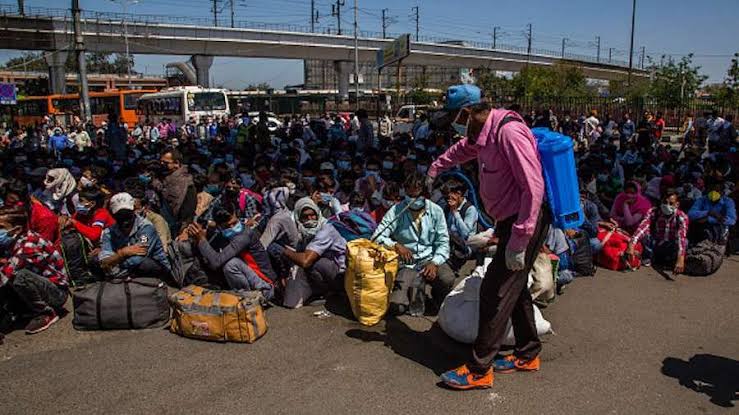
Image Courtesy: Catholic News Agency
by Dr Abhishek Royal and Dr Marcelo Amaral Mali.
The entire world is tirelessly making efforts to stop the spread of SARS Coronavirus 2 and end COVID-19 pandemic. The sight of firefighters spraying disinfectants on roads and buildings using high pressure pump trucks or drones spraying chemicals from sky gives an extreme sense of security to most of us. The provisions of drenching people/workers who are travelling back from affected areas with disinfectants through hose pipes and strict execution of norms to use disinfectant tunnels by general public at public places and disinfectant chambers by health professionals while entering or leaving the health facility are continuously sighted in various parts of the world.
Is there any evidence?
The rationale behind implementing these measures could be to kill the virus present over the contaminated surfaces as reported by a study published in The New England Journal of Medicine (NEJM). The study reported the viability of the virus on contaminated plastic and stainless steel surfaces up to 72 hours and 48 hours and on copper and cardboard surfaces up to four hours and 24 hours respectively. This study states the possibility of transmission of SARS CoV 2 through contaminated surfaces and has been cited widely to implement these interventions of spraying disinfectants on surfaces both in closed as well as open public spaces and on humans. This procedure of disinfection is designed to inactivate or destroy germs on the lifeless objects! Though this process is highly recommended in disinfecting surfaces in infectious healthcare facilities, the effectiveness of these interventions in open public spaces or over humans to prevent transmission of this virus has not been studied yet. The NEJM study was also conducted in an ideal closed laboratory setting and does not confer the survival of virus on contaminated objects in real outdoor settings having huge variations in the availability of sunlight, humidity and ventilation. There is also a lack of availability of quality evidence that proves transmission of the virus through direct contact with these contaminated outdoor surfaces. This actually points towards the unscientific nature of these measures of spraying disinfectants in outdoor spaces and use of disinfectant tunnels to sanitize humans while entering and leaving public places. On the contrary, hospitals, microbiological laboratories and other healthcare facilities including quarantine and isolation units, are areas of high concentration of various infectious agents and the same practice of disinfecting these spaces is quite scientific and also a necessity. There is no research study that proves the efficacy of use of disinfectant chambers in healthcare facilities to prevent transmission of this infection. Likewise, there is no scientific evidence that establishes an association between prevention of transmission of this infection and spraying of disinfectants on people exposed to the virus while travelling back from affected areas. This practice not only ignores the dignity of these people but also results in severe human rights violations. It also results in formation of a mirage of false security, thereby compromising the adherence to other effective public health interventions.
What are the effects of these chemicals?
The chemicals used in the disinfection process are known to cause irritation of skin and mucous membranes including eyes, nose and mouth. These chemicals are not considered to be safe for people with various skin conditions including skin allergies and immune disorders. Those disinfectants which break into chlorinated compounds upon degradation have potential to cause cancers and may enter food chains as a by product of this widespread intervention and can affect animals as well as humans in longer run. These interventions are also associated with huge economic expenditures. Therefore, implementation of these unscientific, unproven and possibly risky interventions should be discouraged considering the limited availability of evidence, funds, resources as well as man power along with the risks associated with them. To address these concerns, the Ministry of Health and Family Welfare, India has recently issued an advisory against spraying of disinfectants on people for COVID-19 management. It is important for policy makers to understand the importance of evidence based approach to formulate and implement public health interventions to effectively contain the spread of this disease and minimize the loss of human lives and resources.
The application of existing Infection Prevention and Control (IPC) measures is still the best approach to stop the transmission. The disinfection procedures should be focused towards infectious and closed spaces until the availability of strong evidence in the favour of massive disinfection. Frequent hand washing is highly recommended to prevent the transmission of this infection. Therefore, proper technique of hand washing along with continuous availability of water and soap should be endorsed in public spaces.

Dr Abhishek Royal (India) and Dr Marcelo Amaral Mali (Timor Leste) are Public Health scholars in Implementation Research in Universitas Gadjah Mada, Indonesia. As the science of COVID-19 is changing continuously, the article is based on the knowledge available on 19th April 2020. The opinions expressed in the article are personal opinions of the authors.
References:
Republished from :
https://www.policycorps.org/post/how-effective-is-widespread-spraying-of-disinfectants-against-covid-19
